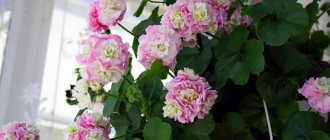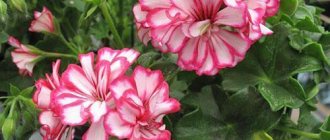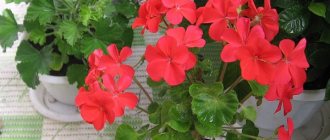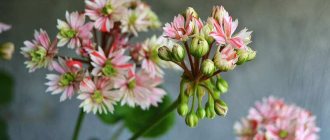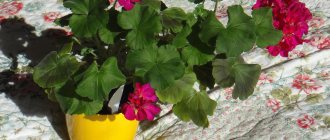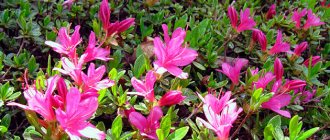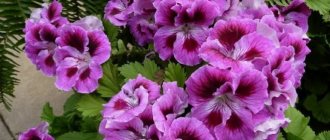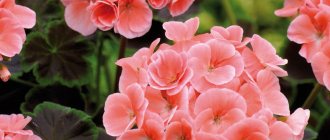Pelargonium angel is a group of geraniums that have a certain set of genetic qualities. Proper care of them at home guarantees lush and long-lasting flowering. It also has another name - the spectacular Viola geranium, distinguished by its magnificent color and shape of the petals.
The Angel pelargoniums group are not dwarf royal geraniums, as some gardeners mistakenly believe. This opinion arises due to the fact that the plants are very similar during the flowering period. Angel pelargoniums are slightly smaller in stature, but their flowers are difficult to distinguish from the other group. Geranium buds are numerous and small in size. Usually, flowering is abundant and very spectacular. Due to the resemblance of the buds to “pansies”, the plant is often called Viola. The article presents the most interesting varieties and their propagation by cuttings and sowing seedlings.
Look what angel pelargonium looks like in the photo, where all its distinctive qualities are demonstrated:
Botanical description, history and price
Pelargonium Angel (Angel pelargoniums) is a plant that appeared as a result of crossing curly and royal species , from which it got dense foliage and medium-sized flowers. This is a fairly old variety, bred at the beginning of the 20th century.
Angelic pelargonium got its name from the word Angeline - in honor of the first variety of the royal subspecies. All varieties of Angel pelargonium available today are hybrids of one or another parent plant. This flower is also called viola pelargonium, or Viola geranium, due to its pansy-like flowers.
A distinctive feature of this species is its ampelous growth, like royal bushes. This type of growth is characterized by downward rather than vertical branches that hang over the edge of the pot.
In a flower shop, pelargonium of this type can be bought for 250 rubles.
Breeding new varieties - history
This plant was first introduced to Europe in the 17th century and immediately gained popularity. In Victorian England, the plant became widespread as a kind of living air flavoring.
The efforts of breeders and the diversity of wild varieties have made it possible to create hundreds of interspecific hybrids and varieties, sometimes completely different from each other.
For example, since the second half of the 18th century, a group of “unique” varieties has been cultivated - these are hybrids of royal pelargonium and brilliant pelargonium.
And the amazing pelargoniums - angels - were bred by amateur gardener Arthur Langley-Smith in 1825. He managed to get them by crossing a low-growing descendant of the thick-growing pelargonium variety Angeline and curly pelargonium. At first, the hybrids bore the name of the author, but then they began to be called simply “angels.”
Description of appearance and features
In appearance, angelic pelargoniums resemble royal pelargoniums in miniature . They usually bloom profusely and feature many flowers against a background of dense double foliage. Angel pelargoniums are not tall, but they are hardy and grow slender and lush. At the same time, their foliage has a fragrant smell, reminiscent of lemon aroma. Violet pelargonium flowers come in a variety of shades, such as pink, purple, white, two or three colors, with a border around the edges.
Distinctive features of flowers of this species are their light-loving nature and resistance to dry weather, as well as ease of care and relatively fast growth rates. But to obtain a beautiful and abundantly flowering plant, it is necessary to provide proper care for it. Typically, the flowering period is about 9 months.
As mentioned above, angelic pelargoniums hang down when growing, so they are well suited for growing in hanging structures and garden flowerpots. It should also be noted that these pelargoniums bloom best in groups, so it is better to plant them 5-7 pieces in one container. If the flower grows in the sun, you don’t even need to trim it, since Angel pelargonium does not lose its shape and maintains a neat appearance.
Royal pelargoniums (Regal)
The name Royal Pelargoniums is adopted in relation to this group of hybrid pelargoniums in the UK, according to the botanical classification it is domestic pelargonium (Pelargonium x domesticum), while in Germany the name grandiflora pelargonium is more common, after one of the parent species - Pelargonium grandiflorum.
|
Royal pelargoniums are characterized by woody shoots at the base, evergreen coarse-toothed, heart-shaped foliage, cup-shaped, folded upward, like the second parent species of this group - Pelargonium cucullatum. The foliage is large and beautiful, its shape ranging from entire heart-shaped to varying degrees lobed, with large, unequal teeth along the edge. Lush inflorescences-umbrellas consist of a few but large, up to 5 cm in diameter, flowers, often reminiscent in general terms of the flowers of simple or double petunias. Due to branching, there are quite a lot of them on the plant, so the flowering is abundant and colorful, from May to August-September. The color of the petals ranges from white to black-red, through the entire spectrum of pink, red and purple tones. Often the petals are decorated with spots or strokes of a contrasting color, corrugated, fringed or torn edges. They, like other pelargoniums, are characterized by pubescence of foliage with glandular hairs, which determine their roughness and the presence of a characteristic geranium odor when touched or rubbed in some varieties (many varieties have odorless leaves).
These pelargoniums feel good on the windowsill only if they are kept cool. In summer, plants prefer to spend time outdoors - for this it is better not to plant them in open ground, where the flowers can be damaged by rain, but to display them in a container in a protected place. The pot should not be large in volume, since highly developed and fattening plants bloom worse. In August, the plants are cut out and kept cool for at least 6 weeks, after which a light and cool window sill is selected for the plants - this is the key to good, abundant and early flowering at the beginning of next summer.
This pelargonium can rightfully be called the queen of window sills, but even in the middle of the last century it was known as a modest “village beauty” that adorned small European settlements. Today this is the second most numerous and commercially available group after zonal pelargonium - hybridizers have been working with it since 1800, and now there are large producers of new hybrid varieties, of which many have already been bred. Here are some of them.
Common varieties and their photos
To date, flower growers have not developed many varieties of Angel pelargonium, since this species is a hybrid . But breeders have developed several beautiful forms, of which the most popular and beloved by all are Angel Viola and Angel Orange.
Viola
Angel Viola is a small neat bush that pleases with abundant flowering all summer long. The flowers of the plant are bright pink and have crimson spots on the petals. The leaves of this plant exude a pleasant lemon aroma that helps improve well-being.
Orange
This variety of angelic pelargonium (Angeleyes Orange) is distinguished by its unpretentiousness and abundant flowering. Angel Orange flowers have a bright pink-orange color, their center is burgundy-brown, and there are burgundy veins throughout the petal. The beautiful openwork leaves of the plant make it decorative. In addition, such bright flowers will be an excellent decoration when decorating garden pots or trellises, and will also give a spectacular look to any room.
Uniques
Most of the unique varieties have been known since the mid-19th century; radiant pelargonium (Pelargonium fulgidum) and its varieties were presumably used for hybridization. These are rather tall evergreen bushy pelargoniums with woody stems, flowers collected in small heads, reminiscent of royal pelargoniums, but smaller in size.
They differ from them by more deeply irregularly dissected leaves, sometimes two-colored, with a pungent spicy odor. The flowers are without fragrance, predominantly red, with dark spots and streaks, less often the color is pink, salmon or white.
This is one of the easiest groups of pelargoniums to grow. In summer they withstand rainy weather well. In autumn, the plants are cut off above the woody parts and transferred to the windowsill. Cuttings root more slowly than those of royal pelargoniums.
This group of varieties is not very numerous, so these are truly unique pelargoniums. Some varieties have survived from the Victorian era, such as Paton's Unique, known since 1870.
- Copthorne - up to 50 cm in height, with leaves quite deeply dissected into lobes, which have a spicy aroma. Light clusters of lilac flowers with purple markings on the upper petals rise above the plant.
- Crimson Unique - up to 50 cm tall, deep wine-colored flowers with a black spot and veins at the base of the petals. The leaves are dark green.
- Mystery - up to 35 cm tall, with rounded, velvety fragrant leaves and inflorescences of deep purple-red tones with an almost black eye and a network of dark veins on the petals.
- Paton's Unique - up to 50 cm tall. The leaves are grayish-green, deeply cut, five-lobed, with an apricot aroma. The flowers are pink with a white throat and chestnut-colored veins.
- Pink Aurore - 30-40 cm tall, with dense inflorescences of large dark pink flowers with maroon spots on the upper petals. The leaves are green, crinkled, deeply lobed.
Where and how to plant?
- If you plant pelargonium seeds, it is better to plant them in the middle of winter in small containers with peat or a 1:1 mixture of peat and sand.
- Then the planting should be treated with a substrate and covered with glass.
- After emergence, it is necessary to maintain soil moisture and an optimal temperature of 20-22 degrees.
- If you brought geranium from the store or replanted it, then for this you need to prepare the optimal soil composition.
- In addition, regular pruning and watering are necessary. It is necessary to take into account that excessive watering can even lead to the death of a houseplant.
Lighting and location
Indoor angelic pelargonium should be grown on well-lit windowsills. In addition, the pot for growing it should be small. In the shade, the plant only grows, but may not produce buds.
Reference. Pelargonium Angel is prone to ampelous growth in the shade and compact growth in the sun.
Soil requirements
To plant and replant angelic pelargoniums, you can buy soil from flower shops that is suitable for geraniums and other indoor flowers. You can also use ordinary soil mixed with peat. Before planting, you should carefully check the soil for the presence of insect larvae and other pests. If purchased pelargonium is replanted, then you should prepare the soil with a composition of:
- turf;
- sand;
- humus;
- leafy soil.
You can also use a nutrient mixture for pelargoniums , which is sold in stores.
Angels
There are many ways to propagate angel pelargoniums, and two of them are most often used: cuttings and seeds. At any flower shop you can purchase or order planting material for the plant.
The seedling method using seeds is most often used to grow pelargoniums, which are preferably grown outdoors. For example, it is easier to prepare seedlings for transplanting into window boxes or large garden pots. Also, this option is suitable if you want to plant plants in group plantings.
Pelargonium seeds do not require pre-sowing treatment. In order to get large perennials by summer, you need to sow from the beginning of December until April. For seedlings, choose shallow containers.
They need to be filled with a mixture of peat and sand. Buries seeds to a level of no more than 5 mm. The soil should be moist. Before the first shoots appear, we cover the plantings with a transparent glass or polyethylene cap.
Cuttings of angel pelargonium are no different from the propagation procedure of other representatives of geranium groups. Most often, this method is used for outdoor perennials that cannot be preserved, for example, due to their large growth.
In the fall, cut the apical cuttings and try to root them in a sand-peat mixture. This procedure should not be carried out in water, as the risk of blackleg disease is very high. Also, you should not root cuttings under a hood, since excess moisture will lead to the development of fungi and the perennial will become very sick and will not be as decorative as healthy plants.
A delicate-looking plant, pelargonium angel, is actually very stable and unpretentious. Many varieties can be easily grown at home, periodically taking them out into the fresh air. This variety does not experience severe stress from climate change.
Pelargonium angel is not fussy about lighting. It grows and develops easily in the sun, like a neat bush or as an hanging plant in the shade. The stems of the perennial do not stretch much and do not lose their decorative appearance as happens in many other plants.
Pruning is carried out twice a year. The first one in the fall is sanitary; it is needed to remove old shoots and prepare the plant for wintering. In spring and summer, it is best to carry out light formative pruning so that the perennial does not grow too much.
This procedure is especially necessary just before flowering begins. In winter, the plant grows greatly and can take up too much space on the windowsill. Small flowers on fallen bushes do not look neat.
Water the plant as needed. Feel the top layer of soil with your finger; if the soil is wet and particles remain on the pad, then the water procedure should be postponed. Water for irrigation use melted, slightly warm water.
Low varieties with medium-sized, appressed, crenate-edged leaves and “angelic faces” of flowers reminiscent of pansies. But they are called angels after the first variety of the miniature royal series, “Angeline,” which was later used in hybridization.
Due to the fact that curly pelargonium (Pelargonium crispum) was included in the hybridization of this group of varieties, some angels inherited fragrant foliage from it. Angels bloom from August to late summer, but the abundance of flowers decreases as autumn approaches. They do not need cold wintering.
- RAS Angeleyes Burgundy – one of the Angelyes Series “Pacviola” varieties with dark purple-red upper petals and the same spot on the lower petals, with a burgundy network of veins;
- RAS Angeleyes Viola is another variety from the Angelyes Series “Pacviola”. It blooms very profusely with medium-sized pink flowers with a crimson spot (larger on the upper petals). The foliage has a citrus aroma.
- Darmsden - up to 30 cm in height, with small rounded leaves, the upper petals are cherry-pink with a dark burgundy spot, the lower petals are white, with a lavender-pink tint.
- Imperial Butterfly - up to 30 cm tall, white flowers with magenta feathers on the upper petals. The foliage is scentless, but the flowers have a faint lemon scent.
- Spanish Angel - up to 30 cm tall, flowers up to 3.5 cm in diameter, upper petals are dark red, almost black, with bright fringed edges, lower petals are pale lilac, with purple feather-shaped markings.
- Tip Top Duet - up to 35 cm in height, with rounded leaves, the upper petals are wine red with pink edges, the lower petals are pale pink with purple veins.
We suggest you familiarize yourself with: Brugmansia main types of angel trumpets
Home care
It should be noted that for abundant flowering, pelargoniums need a cool winter, about 10-12 degrees Celsius. And during the period of active growth, they need to be fed with various fertilizers, like any flowering indoor plant. The presence of phosphorus and calcium, as well as a moderate nitrogen content, is especially important in the fertilizer. In addition, flowers need to be watered in moderation, maintaining soil moisture, and be sure to remove dried flowers.
You should not water the plant with spray fertilizers - this is harmful to the buds. In order for Angel pelargonium to bloom and develop, all that is required is good lighting and optimal air temperature. In winter, if there is a lack of natural light, it is necessary to give it additional light with fluorescent lamps. This condition provides the plant with compactness and abundance of flowering during growth.
Advantages and disadvantages
The advantages of violet pelargoniums include:
- beautiful appearance;
- easy care;
- compactness;
- excellent smelling leaves;
- long flowering period, which lasts about nine months. With due diligence, you can extend it for a whole year.
These flowers will be an excellent decorative decoration for your home, because they have no flaws. However, they, like any indoor plants, need proper care. Otherwise, the geranium will begin to hurt and wither.
Pelargonium variety Angel is a beautiful flower that will be an excellent addition to any gardener's indoor garden.
Common diseases and pests
Great harm to Angel pelargoniums is caused by gray rot , which appears in the form of a gray coating on the leaves. The reason for its occurrence is excessive dampness and poor ventilation of the room. To prevent this disease, it is necessary to provide enough space between plants and promptly clean the plant from dry twigs and leaves.
For the same reason, the plant undergoes stem rotting, which manifests itself in the appearance of dark spots at the base of the latter. Usually this disease cannot be cured, so at least the top cuttings need to be saved.
Like many indoor plants, Angel pelargonium is susceptible to various fungal diseases. For prevention, it is necessary to treat the plant with special solutions.
Also one of the common pests is whitefly, which appears in the form of small white spots or larvae on the bottom of the leaves. When purchasing a plant, you should pay attention to the leaves of pelargonium. Also, before bringing a plant from the garden into the room, it is necessary to treat it with insecticides.
The best varieties
https://www.youtube.com/watch{q}v=sDWBas71gC0
Among these pelargoniums, the best varieties are distinguished:
- Orange The flower has a rich orange color with a salmon tint. Juicy small green leaves, framing this bouquet, add contrast to the composition and complete the natural masterpiece. Hanging shoots and leaves of Orange will become an unrivaled decoration on elegant wicker trellises in flowerpots and other hanging flowerpots.
- Viola. Its flowers resemble violets. The presence of crimson and pink flowers gives the variety a special tenderness. Geranium leaves are distinguished by their leaves, which have a sweetish lemon aroma. The leaves have multiple small hairs on the surface, which is why they have a velvety feel to the touch. This variety likes to overwinter in cool conditions; a temperature of about 15 °C is quite suitable.
- Fallen. Dwarf geranium. It has strikingly bright pink large flowers with denticles at the ends, strewn with small crimson specks. The leaves are dark green, consisting of five “paws” (reminiscent of maple), in the middle of which there is a purple spot.
- Swedish. This variety has strict two-color flowers. The dark burgundy color of the petals is framed towards the edge with a white braid. White color is also present in the middle. These are quite large flowers from the Angels collection.
- Fragrant pelargoniums represent a unique group of varieties whose leaves exude amazing aromas of menthol, lemon, pineapple, apple, peach and other fruits.
- Zonal pelargonium surprises with lush, lush flowering. In terms of the shape of the flowers, zonal pelargoniums are double, as they have more than eight petals in the inflorescence. They have green carved leaves with red-brown edges.
Tags: angel, debbie, pelargonium
About the author: admin4ik
« Previous entry
Features of reproduction
There are several ways to propagate Angel pelargonium - by seeds, cuttings and dividing the bush. Cuttings are considered one of the most productive methods of propagation, since it is this method that guarantees the preservation of the varietal characteristics of the plant.
Cuttings
Angel pelargonium cuttings can be selected at any time of the year, but it is better to do this at the end of winter - beginning of spring, or after flowering has ended.
- Cuttings should be taken from young and strong plants. From Pelargonium Angel you need to cut cuttings 2.5-3 cm long, making an oblique cut at the bottom.
- This end can be treated with charcoal, preventing it from rotting.
- You need to stick the cuttings into the prepared substrate and cover them with a jar or plastic bottle.
- In this case, it is necessary to maintain a temperature regime of about 22 degrees.
- In about 1.5-2 weeks, rooting should occur.
- In addition, the cuttings can be placed in a container of water and wait for the roots to appear.
- After this, the cuttings should be transplanted into a container with soil.
Unlike Pelargonium Angel, other species of this wonderful plant simply amaze the imagination with the number of varieties bred. Particularly popular among them are: Rococo, Andrea, Zonartik, Richard Hudson, Clara Sun, Salmon, Anita, Prince Gustav, Viva and April Snow.
Pelargonium Angel is a wonderful decorative addition to any garden or room. With proper care, it will delight its owner with abundant flowering and fragrant aroma. Its positive qualities include beauty, long flowering period, medicinal properties and ease of care.
Description
Interesting. The culture of the angelic group is distinguished by a compact, fluffy bush and a lemon aroma, expressed to varying degrees, depending on the variety.
Hosta Blue Angel
The leaves of the plants are medium-sized, densely spaced, dissected, with pointed edges. The shade of the leaves is green.
Numerous flowers resemble “pansies” or Viola, which is why they are sometimes called violas. The flowers are simple, characteristic of this group, have two upper, large, rounded petals and three smaller lower ones, arranged in the form of a fan. Unlike the royal group, Angel flowers are small.
The stems of the plant are lignified; in different varieties they are upright or with a tendency to branching.
The bush usually does not reach 30 cm, but there are specimens up to 60 cm.
The color of the petals is spotted, interspersed and edged with combinations of white, pink, lilac, orange and burgundy shades.
Interesting. Pelargonium petals are never blue.
Bright spots of color are present mainly on the upper two petals.
Numerous flowers resemble “pansies”
Location of pelargonium in the house
It is better to place the pot with pelargonium as close to the window as possible. The plant requires a lot of light and fresh air.
During ventilation, the flower is protected from drafts . At the end of spring and throughout the summer, it is better to expose pelargonium to fresh air - in the garden, on a loggia, in a place that is also protected from drafts and with plenty of light.
In winter, a mild rest period begins. The plant hardly grows, does not bloom and requires low temperatures. In winter, the best place for pelargonium is also on the windowsill.
Pros and cons of a flower
Even judging by the description, we can confidently say that angel flowers have no drawbacks. They have more than enough positive characteristics:
- beauty of flowering and its duration;
- easy care;
- amazing smell;
- additional decorative qualities.
We hope our article will help novice flower growers, and they will have a desire to grow their own beautiful Angel pelargonium.
myorchidea.ru
Flower passion.
I love all living plants. I see a highlight in each of them. But my strongest flower passion in recent years has been pelargoniums.
Dear readers, at the moment I have a small but amazingly beautiful collection of unusually blooming pelargoniums. I have “Rosebud” - pelargoniums blooming with roses, Tulip - blooming with tulips, asters, carnations, one variety - peonies. There are several fragrant varieties, with the scent of rose, lemon, wormwood, peach, and apple. And I want to share all this wealth with you.
Terms of sale of pelargoniums 2022
Sales all year round, subject to delivery by a transport company, by bus, I arrange it myself. To the order amount you need to add approximately 400 rubles for transportation and packaging. I don’t send pelargoniums by mail because they don’t arrive well, then they get sick for a long time and, as a rule, they don’t survive.
My email address
Viber and WhatsApp tel.
1. Pelargoniums of the Rosebud series and Rosaceae
Apple Blossom Rosebud is a rosaceous zonal pelargonium. The plant is very large and fast growing. It requires the initial formation of the bush, and then it will show all the beauty and harmony of flowering. Loves very “fat” soil. Last year I fed them with liquid fertilizers for the flowering ones, but this year I just planted them in “humus” in the spring. The variety blooms very profusely, begins early in the spring and, probably, if not pruned in the fall, will bloom into the winter. This photo is fresh from autumn, I published it only because of its good quality, it does not reflect the true beauty of the variety. In summer the hats are much larger and denser. I especially admire roses - large white ones with a green center and pink edging of delicate petals.
2. Pelargoniums of the Tulip series, blooming tulips
.
anykadevyshki.ru
Rooted cuttings of varietal pelargoniums in St. Petersburg. I send by mail!
1. Deacon Moonlight - stalk 250 rub. 2. Deacon Peacock - adult plant 400 rub. 3. Diemierii Schafferi - large cuttings 300 rubles, smaller ones 250 rubles. 4. Odensjo Liesel - large cuttings 350 rub. Reservation! 5. Brightstone - cuttings 300 rub. Sold! 6. Hero - teenager in a pot 350 rub. 7. PAC Vicky ivy - 300 rub. 8. Joann Hodgson stellar - cutting 200 rub. 9. PAC Lauretta - Sold! There will be more - reserve! 10. PAC Flower Fairy Berry - 250 rub. 11. Trumphs - cuttings 200 rub. 12. Red Rambler 200 rub., 250 rub. 13. Mme Recamier - 300 rub. reservation! 14. PAC Victor - 250 rubles, 15. Shan Hoy - 300 rubles. 16. Okka ivy - 250 rub. 17. Lara Prince (zonartik) - 400 rubles. 18. Bold Sunrise - large cuttings - 350 rub. Reservation! 19. Bold Carmine - 250 rub. small 20. PAC Emilia - 250 rub. Sold! 21. Hannah West - 350 rub. 22. Diana Palmer - 250 rub., 300 rub. Reservation! 23. Barnstondale - large 300 rub. Reservation! 24. Granny Barter - large cuttings - 350 rub. 25. Rosebud Supreme - 250 rub. 26. Brookside Betty - 300 rub. Sold! 27. Saxdalens Selma - 350 rub. 28. Dibbinsdale - 250 rub. 29. Pukin Kili - 300 rub. 30. Lady Mawis Pilkington - 400 rubles. 31. High Tor - 300 rub. 32. Black Country Bugle - 400 rub. Sold! 33. Occold Lagoon (Belgium) - 300 rubles. 34. Tamara - 300 rub. 35. PAC Viva Rosita - 400 rub. 36. Rushmoor Golden Girl - teenager in a pot - 350 rub. 37. Clatterbridge - 300 rub. Reservation! 38. Bornholmpelargon - 250 rubles. 39. Golden Anniversary - 250 rub. 40. Good Vibration - teenager in a pot 350 rub. 41. PAC Foxy - 300 rub. Sold! 42. Princess Desiree - 400 rub. 43. April Snow - 250 rub. 44. Sutarves Klara San - 300 rubles. 45. Odensjo Madam Bovary - teenager in a pot 800 rub. 46. Odensjö Rodluvan - 250, 300 rubles. 47. Mimi - cuttings bloom - 300 rub. 48. Potter Heigham - cuttings bloom - 350 rub. Reservation! 49. Ainsdale Duke - cuttings bloom - 400 rub. 50. Ununges Molly - teenager blooms - 600 rub. 51. Pink Pandora - large stalk - 450 rub. 52. Fischers Appleblossom - cuttings bloom - 500 rub.
There will be additions!
vk.com
Growing rules
In addition to beautiful flowers, pelargonium has another undeniable advantage - it is simple and easy to care for.
Unpretentiousness applies to all angelic varieties and attracts the attention of gardeners. Ease of care also lies in the fact that the branches do not need to be pinched to create a better shape.
The plant looks great without manual intervention. The small size of the bushes allows you to plant several of them in one pot. It has been noticed that when grown in groups, Angels bloom better. As already noted, the flowering period is quite long. It is possible to achieve maximum results at home with proper care.
Angel geranium care involves:
- Proper watering. Excess moisture causes rotting of the root system, which can lead to the death of the plant. Dry soil is also unacceptable. This means that we need to find a “golden mean”. Checking the need for watering is easy: just press your finger on the soil. Water for irrigation should be at room temperature.
- Geraniums should be placed on windowsills with sufficient light.
- Remember the need for fertilizers. Pelargonium will “thank you” with its beautiful color only if it is regularly fed with special mineral compounds, starting from early spring and ending in autumn.
- When the bushes grow, they should be transplanted into a flowerpot larger than the previous one.
- A constant temperature regime is required, especially during the flowering period.
- Light cosmetic pruning is needed in spring and autumn.
Pelargonium in spring: Spring pruning
Pruning is carried out in early spring, before flowering , when the plant has already begun to grow. If flower shoots have already appeared, it is better to remove them so that the flower has time to grow leaves. Flowering may begin a little later, but will be more abundant.
Dormant buds on the stem awaken and many young leaves appear. The grown bush is subjected to radical pruning, taking into account the summer development of the plant.
To do this, trim long, elongated branches, especially if they are weakened. Old branches are cut almost to the root, leaving young shoots. Preference is given to shoots growing closer to the root; shoots growing higher should preferably be removed.
If the shoot has a lot of leaves, then 4-6 leaves are left, the rest are removed or pinched .
When pruning, you should always assume the further growth of the flower and its future shape. Be sure to leave one strong shoot with leaves or growing points. The height of the trimmed bush is usually about 10 centimeters.
After pruning, the flower is shaded and not watered for two to three days.
During the summer, overgrown shoots of actively growing plants are pinched off on the fifth or sixth leaf.
The pruning procedure seems complicated, but in practice it is a very simple task that promotes the health of pelargonium and its long flowering.
Pelargonium is propagated by seeds or cuttings.
Cuttings are a more reliable method, this is especially important for varietal plants and hybrids, since propagation by seeds does not always transmit varietal characteristics. In addition, it is easier to obtain cuttings - almost always, when pruning, healthy and strong cuttings are left, suitable for rooting.
Landing
Let’s find out what requirements the “Angels” have for their place of detention, soil and other vitally important aspects.
Location and lighting
Pelargonium Angel prefers well-lit places , so choose an appropriate window sill in the house for the plant.
The soil
These decorative types of pelargonium are not too demanding on the quality of the soil. For the successful growth and development of plants, it is enough to provide them with optimal lighting and air temperature. For violet pelargoniums, any purchased soil is suitable - intended both for pelargoniums and geraniums, and for universal use.
Some gardeners also take ordinary turf soil, mix it with peat, and plant pelargonium. It is important, however, to disinfect the self-prepared substrate.
The soil from the garden may contain pathogenic microbes, as well as larvae and eggs of harmful insects. If you do not get rid of them at the soil preparation stage, they can subsequently significantly harm the plant and even lead to its death.
Pelargonium Angel will bloom best in a small pot - take this fact into account when choosing a “house” for the plant. The size of the container should only slightly exceed the diameter of the flower roots.
Air humidity
As a native of arid African regions, pelargonium tolerates low indoor humidity well. Moreover, excessive moisture can lead to rotting of the stem and leaves. Spraying is highly undesirable .
And yet, if the air is too dry, the leaves of pelargonium may dry out. At the first signs, it is necessary to increase the air humidity, but not by spraying, but by placing containers of water nearby. You can install a humidifier, but so that moisture does not fall directly on the leaves.
Varieties
Let's look at some of the most popular varieties of "Angel" today.
"Angel of Burgundy". “Burgundy” has almost no white spots on the flowers; the color of the petals varies from dark scarlet on the upper ones to bright pink on the lower ones. It blooms profusely with bright “violas”, sparkling shades of pink, and delights its owners for about 9 months a year.
"Angel Bicolor". It got its name from the contrasting color of the inflorescences: the large upper petals have a crimson tint, the lower petals are pale pink, lavender. Blooms early, with careful care it pleases the owner with flowers until late autumn
"Randy's Angel" Small-flowered pelargonium. It has small flowers about 2 cm in diameter, with crimson spots and a light edge. Miniature carved leaves with a diameter of 1.5-2 cm. The stems are not straight, but slightly inclined, but with proper pruning they form magnificently. In the ampel planting option, the branches fall in picturesque waves. According to flower growers, the perennial is distinguished by its longevity.
"Angel Debbie" Miniature bushes are 20-30 cm high; their small size does not prevent them from delighting with unusual flowers. The petals are indented along the edge, the upper ones are brightly colored, the lower ones are lightened. Woody straight stems, large leaves compared to other hybrids.
Varieties
Pelargonium ivy leaf
Let's look at several of the most popular varieties of "Angel" today.
"Angel of Burgundy". “Burgundy” has almost no white spots on the flowers; the color of the petals varies from dark scarlet on the upper ones to bright pink on the lower ones. It blooms profusely with bright “violas”, sparkling shades of pink, and delights its owners for about 9 months a year.
"Angel Bicolor". It got its name from the contrasting color of the inflorescences: the large upper petals have a crimson tint, the lower petals are pale pink, lavender. Blooms early, with careful care it pleases the owner with flowers until late autumn
"Randy's Angel" Small-flowered pelargonium. It has small flowers about 2 cm in diameter, with crimson spots and a light edge. Miniature carved leaves with a diameter of 1.5-2 cm. The stems are not straight, but slightly inclined, but with proper pruning they form magnificently. In the ampel planting option, the branches fall in picturesque waves. According to flower growers, the perennial is distinguished by its longevity.
"Angel Debbie" Miniature bushes are 20-30 cm high; their small size does not prevent them from delighting with unusual flowers. The petals are indented along the edge, the upper ones are brightly colored, the lower ones are lightened. Woody straight stems, large leaves compared to other hybrids.
Feeding and fertilizing pelargoniums
Pelargonium responds well to feeding. In spring and summer, the plant is fertilized once every two weeks. In winter, during the dormant period, feeding is stopped completely.
After leaving the dormant period, at the beginning of spring, with the awakening of the plant, mineral fertilizers with a high nitrogen content are applied once to increase the green mass, and subsequently - fertilizers for flowering plants .
To stimulate and more luxuriant flowering, it is recommended to water the flower once a month with an iodine solution - 1 drop per 1 liter of water. Water the flower with this solution carefully, in no case at the root, but along the edges of the walls of the pot and strictly into the already moistened soil in a small amount. If you do not follow these precautions or make a high concentration of the solution, you can burn the roots and destroy the plant.
Watering pelargonium
